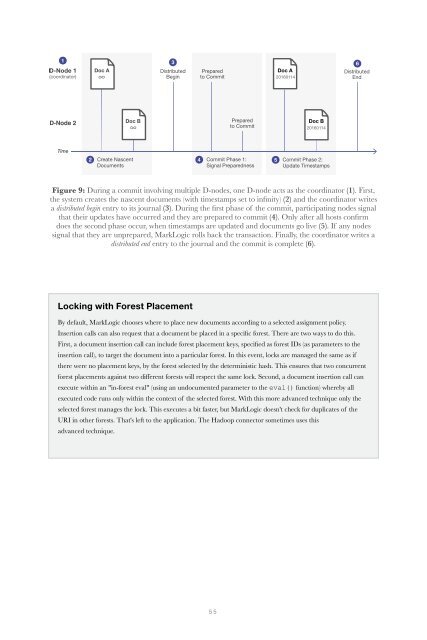Create successful ePaper yourself
Turn your PDF publications into a flip-book with our unique Google optimized e-Paper software.
Figure 9: During a commit involving multiple D-nodes, one D-node acts as the coordinator (1). First,<br />
the system creates the nascent documents (with timestamps set to infinity) (2) and the coordinator writes<br />
a distributed begin entry to its journal (3). During the first phase of the commit, participating nodes signal<br />
that their updates have occurred and they are prepared to commit (4). Only after all hosts confirm<br />
does the second phase occur, when timestamps are updated and documents go live (5). If any nodes<br />
signal that they are unprepared, MarkLogic rolls back the transaction. Finally, the coordinator writes a<br />
distributed end entry to the journal and the commit is complete (6).<br />
Locking with Forest Placement<br />
By default, MarkLogic chooses where to place new documents according to a selected assignment policy.<br />
Insertion calls can also request that a document be placed in a specific forest. There are two ways to do this.<br />
First, a document insertion call can include forest placement keys, specified as forest IDs (as parameters to the<br />
insertion call), to target the document into a particular forest. In this event, locks are managed the same as if<br />
there were no placement keys, by the forest selected by the deterministic hash. This ensures that two concurrent<br />
forest placements against two different forests will respect the same lock. Second, a document insertion call can<br />
execute within an "in-forest eval" (using an undocumented parameter to the eval() function) whereby all<br />
executed code runs only within the context of the selected forest. With this more advanced technique only the<br />
selected forest manages the lock. This executes a bit faster, but MarkLogic doesn't check for duplicates of the<br />
URI in other forests. That's left to the application. The Hadoop connector sometimes uses this<br />
advanced technique.<br />
55


